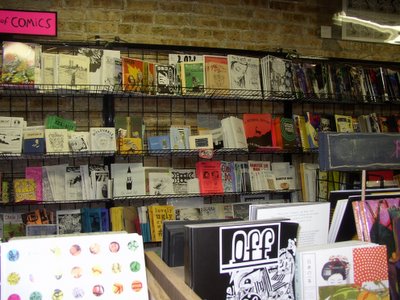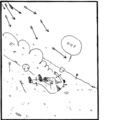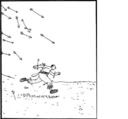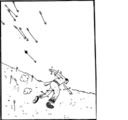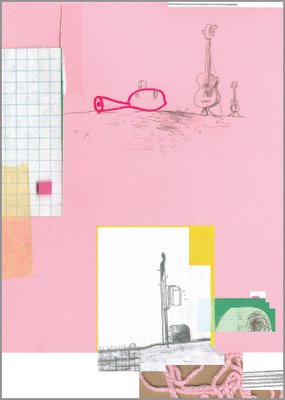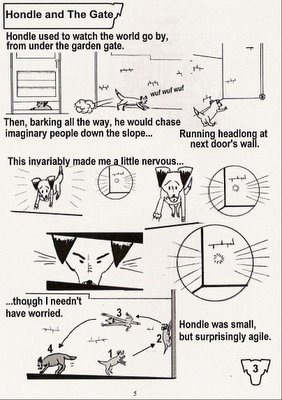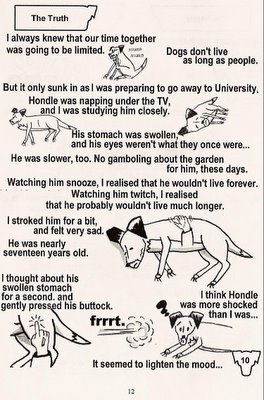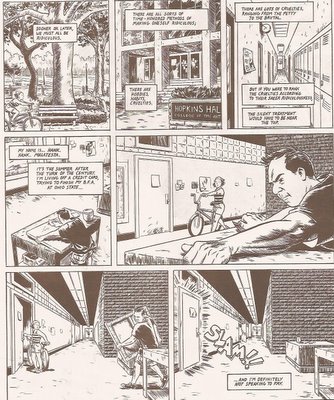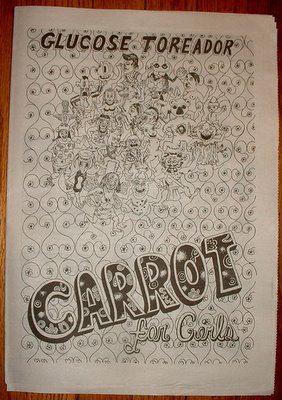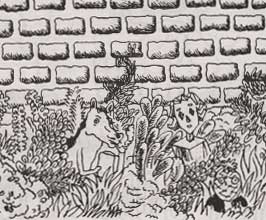Reactions to Unfamiliar ArtA few years ago, I wrote a column called “Reactions to Unfamiliar Art.” In it, I used a then ongoing, but now about to be published Sammy Harkham strip called “Black Death.” What was “Black Death” is about to be published in the Drawn & Quarterly comic, Crickets.
This was one of my favorite columns from that time. Not only because I’m such a huge fan of Harkham’s work, but it gave me some insight into how people approach comic art that may be unfamiliar to them.
Here’s the column. Again, a few of the pictures above were part of the strip that inspired the column:Reactions to Unfamiliar ArtMonths ago, Jordan Crane posted the first installment of Harkham’s new story
Black Death at his excellent website, Reddingk, and I immediately linked to the strip in The Wall forum (this forum and the original columns are no longer online). It looked like a great beginning to another Harkham story and I was anxious to be able to share the strip with others. The first part of the story received a fair amount of comments, including:
“The art is too crude.”“It struck me as a bit too simplistic and amateurish.”Not what I expected, but I should know better than being surprised over reaction to comic art. One of the great things about writing this weekly column is reading posts from readers to unfamiliar artists and comic art. These responses have frequently been illuminating, causing me to wonder why I am so enamored of certain creators and others are less than impressed. To be fair to the individuals quoted and to the artist, the above quotes are taken out of context and do not fully represent the thoughtful responses that this strip received. The full quotes and comments are provided below. You can also view the strip yourself at Jordan’s website.
After posting the link to
Black Death, the first comments about the strip were:
“Well, I’m a little freaked out.” –Matthew
And
“Ummm…I certainly wouldn’t pay for this.”-Mike
Not a good start, and it got me thinking about why I was so excited about the strip and others had such a negative reaction to it. I asked for further thoughts to clarify why people reacted to the strip the way they did.
Matthew added the following:
“OK, first off - the figure of the guy is disconcerting. He is disfigured and bulbous and the arrows in him don't help either.
Secondly, while the effect of movement and urgency is achieved well there is no sense of narrative that can actually explain his predicament. As a result it seems emotionally empty and develops no real connection to the reader. It seems reasonless and as a result is disconcerting.”That gives us something to work with. Matthew intelligently explains why he feels no connection to
Black Death. The figure running down the hill seems “disfigured and bulbous.” This didn’t occur to me at all when I read the strip, although I have often groaned at figures, especially in most super hero comics, as “disfigured and bulbous.” Many mainstream comic artists, exaggerate and pervert human anatomy in ridiculous and offensive ways, but these artists are held in high regard by their fans and readers. Therefore, Matthew and I have similar problems with comic art, but we view it in different ways.
Matthew does praise the story for the sense of movement, which is the whole point of the strip at that point, but he has concerns about the lack of narrative to explain the plot. That seems to be a key difference in “art comics” and “mainstream” comics. An “art comics” artist will often allow several panels or even pages to go by, letting the art itself work out the narrative, while mainstream books tend to spell everything out up front. In Sammy’s strip, what is going on seems obvious, but the mystery remains, making me even more curious why the guy is being chased down a hill by a storm of arrows. Thus, I am interested in the strip and the events that brought the characters to this point.
Mike was also kind enough to clarify his initial reaction:
“Essentially, I think the best way to describe this is to tag it with the term "Punk Art". Why "Punk Art", well "Punk Rock" originally came out as a backlash to mainstream music. You didn't have to be a talented musician, you didn't have to have years of practice on your instrument, you didn't need one lick of established songwriting skills...you just had to have the will and the means to produce something vaguely resembling a song.
This strip is just that to me...the guy can tell a story sequentially, but so can I and I wouldn't expect anyone to plunk down cash for my artwork.
I'm not saying it's bad, but when you hold it up against Lee, Di Vito, Basuldua, Kirby, Buscema, etc. it almost borders on the ridiculous.
Again, no offense to the artist, but the story is not engaging, intriguing, dramatic or compelling. So with essentially no worth in what is being told and no crafted art to convey the 'story', it's worth to me is not equal to what I spend my money on...in my opinion.
As to my comments comparing him to other artists, it's not so much the style, but the fact that those folks I mentioned have devoted the time, energy and effort into crafting their skill into something extraordinary. The link above is something I think almost anyone could whip out in very little time, with little or no formal training or practice (I'm not out to detract from what this fellow is trying to achieve, but merely clarify my own personal take on it.) I was merely using the artists I named to reinforce the 'Punk Art' reference.”Mike and I have very different tastes in comic art (almost polar opposites at times), but I appreciate that he is able to clarify his feelings about Harkham’s strip. Harkham’s style doesn’t meet the criteria that Mike uses to decide how to spend his comic money and that is only something that Mike can decide. My bone with his comments are twofold though, he is judging the work on the first installment only, and he underestimates the amount of work that Harkham put into the strip. I don’t know Harkham personally, but I know his work and I know that he studies animation. He’s certainly not trying to create a hyper-muscled Jim Lee style figure against an overly detailed background; he’s trying to create a sense of movement and urgency, by using a very economical style of art.
Though comic artists study anatomy and spend inordinate amounts of time on getting every detail right, sometimes the details left out are the ones that make the artwork click. I respect the time and the sweat that artists put into learning their craft, especially someone like Buscema or Kirby, both of whom Mike mentioned, but I guess I’m often drawn to artists that use a more spare style of line. Charles Schulz comes to mind; he uses just enough line to let the reader know what’s going on, and then leaves the rest of the details to the individual reader. I think this style helps explain his almost universal appeal among comic fans and non-comic fans alike. By making the reader fill in the gaps, he allows the reader to identify with the characters and the surroundings.
Here is another take on the same strip by Adam:
”Just watching him over the course of those several panels on the first page run from the arrows...christ, he's got that sense of movement that only people like Chester Brown or Frank Quietly have. Mind you what makes this work the most is extreme Tezuka style decompression. He spends sixteen panels to portray the entire chase, which is often this guy rolling down the hill or running form the arrows (with several in him!) yet they are just amazing in the way that this Harkam guy captures the sense of movement. He then uses two panels to show him recovering before he raises his arm triumphantly for having escaped alive, and I feel it captures the sense of recover/relief/victory very effectively for the circumstances. His forms are very simplified and slightly crude, but his sense of movement, pacing, and composition is amazing...makes me wonder if the roughness of the style is deliberate... However, looking at it I don't see this as something that could possibly be whipped off in such a short time. The figure and action and panels move in a manner that's much more natural and limber than his crude rendering suggests. I could pull off a better looking figure than him, but I'd be at a loss to achieve the illusion of movement he creates here.Adam immediately identifies the sense of movement and the type of forms that Harkham chooses to use in telling his tale. I agree with him that the simplified forms and “roughness of style” seem a deliberate choice by Harkham, and that it would be more difficult than it appears to recreate such a sequence. Sequential storytelling is difficult, and much more difficult when you choose to create a story with such an economical line and a nearly wordless narrative.
Eric adds the following, which captures the feeling that I expected people to have, except for the annoyance part.
”I thought it was amusing but a little "one-note." I appreciate what Paul Weller (Adam) was saying about the sense of movement but honestly, panel after panel of a guy running from a hail of arrows was a little frustrating. During the first few, I was laughing because of the absurdity of it and how long it was being stretched out. Like a movie chase scene that just doesn't end. But (for me at least), it passed the point of being funny and just got annoying. I kept waiting for a payoff that just didn't come.
That second page with what I can only assume is Death waiting for this guy was winning me back though. That was kinda intriguing. Took a long time to get there though.”Eric did come back to check on the story, so Harkham was able to capture his interest. However, Eric identifies a feeling that seems prevalent to many people who are turned off by “art comics.” The panel pace to payoff ratio is different from your typical mainstream comic. Many readers may be unaccustomed to the slower pace or style that captivates other readers. Mainstream comics are all about “bang for the buck,” which goes a long way in explaining negative reader reaction to Jones’ run on
The Hulk or Bendis’ run on
Daredevil, both of which I really enjoy.
Todd gets the last reaction:
”The art is too crude, though I appreciate the consistency, and there isn't enough story to suggest that this tale is going to affect me in anyway. Still, the action presented and the questions raised by the characters ability to survive, are intriguing enough to have me add the site to my favorites, so I can check back later on the story.”Again, the art does not seem like Todd’s cup of tea, but it is enough to have him bookmark the site and check up on the story later. That is all I can ask for and I appreciate the comments left by everyone. I meant to include only negative reactions, but Adam’s comments seemed so in tune with what I got out of the strip that I had to include them. I also picked these comments, because I feel that they mirror common reactions that people have to unfamiliar art styles.
My intent behind this week’s column was not to criticize the reactions by the people that I quoted, but to explore why we feel differently about certain works and ideally generate some discussion about our reactions. Many thanks to Matthew, Mike, Adam, Eric and Todd for their responses, also to Jordan Crane for posting these weekly installments (I hope there are more after the fourth). Sammy Harkham has a website where you can order his mini-comics as well as the anthology Kramers Ergot.
I thought to post this old column, because the strip discussed is basically the strip that you’ll see in Crickets. I haven’t seen Crickets yet, but I’ll be grabbing a copy this Saturday night at Quimby’s. Looking at this old column was kind of fun, I was much kinder back then I think. Jim Lee and art?

